- External21 Jun 2012
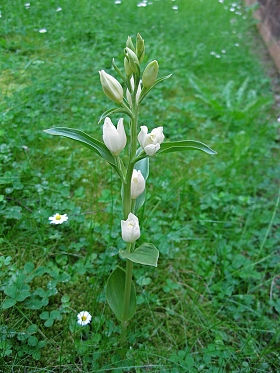 White Helleborine (Cephalanthera damasonium)
White Helleborine (Cephalanthera damasonium)The beautiful orchid that took 10-15 years to develop in front of our front door has been mowed down by the mechanised services that this University pays to create green deserts. I arrived too late, but I have again received a promise that it will not be mowed until we want it. I saved the other half of the wild flower meadow. Never give up!
-Peter Somogyi
- Unit18 Jun 2012
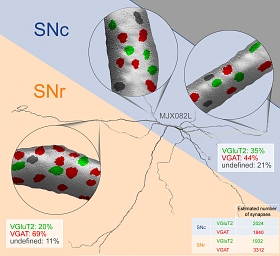 Summary of synaptic input to dopamine neurons
Summary of synaptic input to dopamine neuronsStructural correlates of heterogeneous in vivo activity of midbrain dopaminergic neurons
Pablo Henny, Matthew T. C. Brown, Augustus Northrop, Macarena Faunes, Mark A. Ungless, Peter J. Magill and J. Paul Bolam Nature Neuroscience (2012) 15:613-619
Dopaminergic neurons of the substantia nigra pars compacta (SNc) exhibit functional heterogeneity that is likely to underpin their diverse roles in behavior. We examine how the functional diversity of identified dopaminergic neurons in vivo correlates with differences in somato-dendritic architecture and afferent synaptic organization. Stereological analysis of individually recorded and labeled dopaminergic neurons of rat SNc revealed that they receive approximately 8000 synaptic inputs, at least 30% of which are glutamatergic and 40%-70% are GABAergic. The latter type of synapses are proportionally greater in number and denser on dendrites located in the substantia nigra pars reticulata (SNr) than on those located in SNc, thus revealing the existence of two synaptically-distinct and region-specific subcellular domains. We also show that the relative extension of SNc neuron dendrites into the SNr dictated overall GABAergic innervation and predicted inhibition responses to aversive stimuli. We conclude that diverse wiring patterns are key determinants of the heterogeneous activities of midbrain dopaminergic neurons in vivo.
See Commentary by Javier and Krietzer Nature Neuroscience (2012) 15:503–505.
- Unit1 Jun 2012
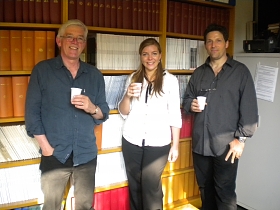 Paul Bolam, Natalie Doig and Enrico Bracci (Left to right)
Paul Bolam, Natalie Doig and Enrico Bracci (Left to right)Natalie Doig successfully defended her thesis entitled "Cortical and thalamic innervation of the striatum" on the 29th May 2012. Minor corrections have been requested by the examiners.
Natalie was supervised by Professor Paul Bolam. Her internal examiner was Zoltán Molnár, Professor of Developmental Neurobiology, Cerebral cortical development; and her external examiner was Enrico Bracci, senior lecturer at the Faculty of Life Sciences, University of Manchester.
- External1 Jun 2012
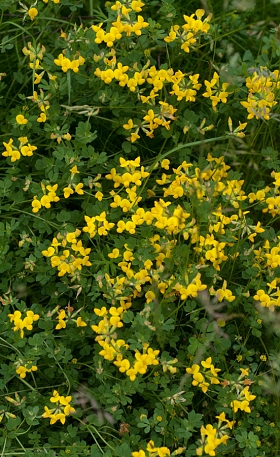 Bird's-foot Trefoil
Bird's-foot TrefoilAs well as the rare White Helleborine (see previous news item), the area around the entrance to the Unit supports several wildflower species- some can be see in the photos accompanying the full version of this news item. There is also a vegetative White Helleborine, which bodes well for future flowering plants.
For those wanting to see more wild flowers, especially orchids, there are several excellent sites in the Chilterns. A very impressive display of Common Spotted and Fragrant Orchids can be seen at Aston Clinton Rag Pits, also an important site for butterflies. The Berks, Bucks and Oxon Wildlife Trust's flagship reserve at Warburg is also a good place to see several orchids and the Chiltern Gentian (a bit later in the year). For those wanting to see a wide range of rare orchids in a small space, Homefield Wood is a great destination and one of the only UK sites for Military Orchid. Another good site for rare orchids is Hartslock, where you can see Monkey and Lady Orchids, it is the only site in the UK where these two species have hybridised, and many intermediate forms can be seen. When visiting these sites, please be very careful where you are walking.
In other wildlife-related news, the Unit's two Blue Tit chicks successfully fledged yesterday evening.
- External25 May 2012
 White Helleborine (Cephalanthera damasonium)
White Helleborine (Cephalanthera damasonium)This year finally I have managed to reach agreement with the park services, that they do not mow on a fixed schedule the grassy areas in front of the Unit, but allow wild flowers to bring flowers for insects to feed on. The sad fact is that due to Hollywood and TV indoctrination, as well as to innate fear of the uncontrolled and the wild, most people like to see grassy areas mowed to 1 cm and monocultures, without wild plants, and consider that nice or even beautiful. But Nature’s variety is much more beautiful for those who have insight; those of us working on the brain, have some idea of beauty in nature.
As a result of the first unmowed spring a rare orchid, a White Helleborine (Cephalanthera damasonium) blooms under the birch trees. Just look at Ben’s picture! And the real thing! Please do not damage the plant, most of you will never see another one ever in your lives,The seed of this orchid is carried by the wind and after germination the plant develops under ground for eight years in symbiosis with fungi. It cannot develop further without the appropriate mycorrhizal symbionts. It takes another 5-7 years of above ground development before the plant flowers for the first time. A real long-term project which is matched by some of my papers as time goes on.
Yours,
Peter Somogyi
- External24 May 2012
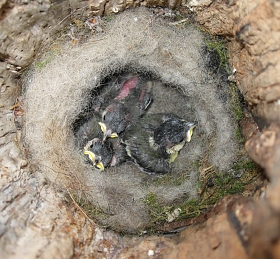 Three great tit chicks
Three great tit chicksThe Unit has once again been home for nesting birds. This year both the nest box in the car park and the one outside of Prof. Somogyi's office window have been occupied. The car park box has Great Tits nesting, and they have produced three chicks, and Prof. Somogyi's office box has Blue Tits, and currently has two chicks.
The wet start to the summer led to few insects, and a poor start for the chicks, and many have died. Now the warm weather is providing good conditions for growing big juicy caterpillars, and the blue tits have been observed bringing these in for for the chicks. The prospects for these two remaining chicks looks good.
- External13 May 2012
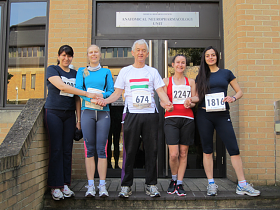 Cristina, Kristina, Peter, Kathryn and Eleftheria.
Cristina, Kristina, Peter, Kathryn and Eleftheria.Unit down in numbers but up in spirit in the Town and Gown 10 km race
Numbers were down this year, only the best and the strongest battled on from the Unit again in the 10 km Town and Gown fun charity run supporting the Muscular Dystrophy Campaign. On the 13th of May, Eleftheria Pissadaki (51.48) and Kristina Detzner (52:30) have overtaken Peter Somogyi (53:51) for the first time, while Kathryn Newton (54:35) made a dramatic 5 min improvement on last year. Marriage celebrations took their toll on Cristina Martinez-Gonzales, who nevertheless finished in a respectable (77:02) time on the warm May sunny day. The over 3000 runners watched in awe as Edao Veliy from Ethiopia broke the course record with an incredible 29:27 in the 31st race of this annual event. From the team of The MAGYARS, daughter Lilla came in fastest at 46:32, son Levente at 47:07, daughter in law Claire at 53:01 and girlfriend Beata at 61:48. Although Peter was down by 41 sec on last year’s time, he kept his grading at 61.21, proving yet again how good vintage improves with age.
View all Results.
- Unit12 May 2012
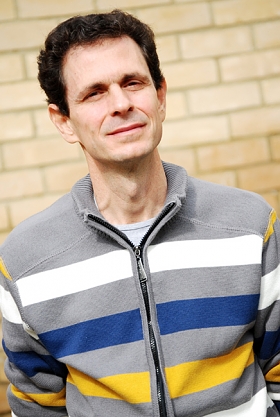 Dr. Albert SouzaDr Albert Souza graduated from the State University of Londrina, Brazil (1988). He obtained his Master's (2000) and PhD degree (2004) in Sciences at the University of Sao Paulo, Brazil where he studied the putative role of neuronal nitric oxide (nNOS) on neurodegeneration/regeneration following injury. Albert is a Lecturer from Federal University of Mato Grosso do Sul (UFMS/Brazil) and joined the Bolam lab in 2012 as an Academic Visitor for 12 months, supported by UFMS and People Marie Curie Actions: International Research Staff Exchange Scheme. Under the supervision of Dr Juan Mena-Segovia, he will be using electrophysiological methods to characterise the interaction of the pedunculopontine nucleus with other midbrain/brainstem structures.
Dr. Albert SouzaDr Albert Souza graduated from the State University of Londrina, Brazil (1988). He obtained his Master's (2000) and PhD degree (2004) in Sciences at the University of Sao Paulo, Brazil where he studied the putative role of neuronal nitric oxide (nNOS) on neurodegeneration/regeneration following injury. Albert is a Lecturer from Federal University of Mato Grosso do Sul (UFMS/Brazil) and joined the Bolam lab in 2012 as an Academic Visitor for 12 months, supported by UFMS and People Marie Curie Actions: International Research Staff Exchange Scheme. Under the supervision of Dr Juan Mena-Segovia, he will be using electrophysiological methods to characterise the interaction of the pedunculopontine nucleus with other midbrain/brainstem structures. - Unit12 May 2012
 Gido van de Ven
Gido van de VenAfter graduating in Econometrics at the Erasmus University Rotterdam in 2008, Gido van de Ven completed an MA in Statistics at UC Berkeley in 2011. In Berkeley and Rotterdam, he focused on time series analysis, machine learning and, in particular, the estimation of causal interactions between brain regions from functional MRI data. In 2011 Gido moved to the University of Oxford commencing an MSc in Neuroscience. As part of this course he spent four months working with Dr Riikka Möttönen studying the role of the articulatory motor cortex during speech perception in a combined TMS/MEG-experiment.
Gido has joined the Unit for five months as a member of the Bolam lab. Under the supervision of Dr Juan Mena-Segovia he will be characterising the synaptic organisation of brainstem structures by means of the juxtacellular labeling technique.
- Unit12 May 2012
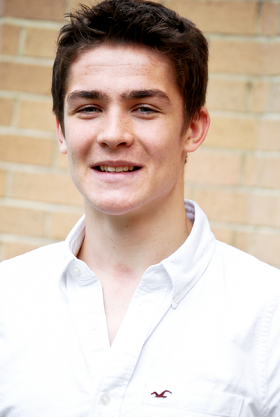 Joe LarvinJoseph (Joe) Larvin has joined the group of Pete Magill to complete his Final Honours School research project, as part of his BMBCH medical degree at the University of Oxford. Joe will use light microscopy and immunohistochemistry to define the molecular specification and developmental origin of distinct types of globus pallidus neuron.
Joe LarvinJoseph (Joe) Larvin has joined the group of Pete Magill to complete his Final Honours School research project, as part of his BMBCH medical degree at the University of Oxford. Joe will use light microscopy and immunohistochemistry to define the molecular specification and developmental origin of distinct types of globus pallidus neuron.